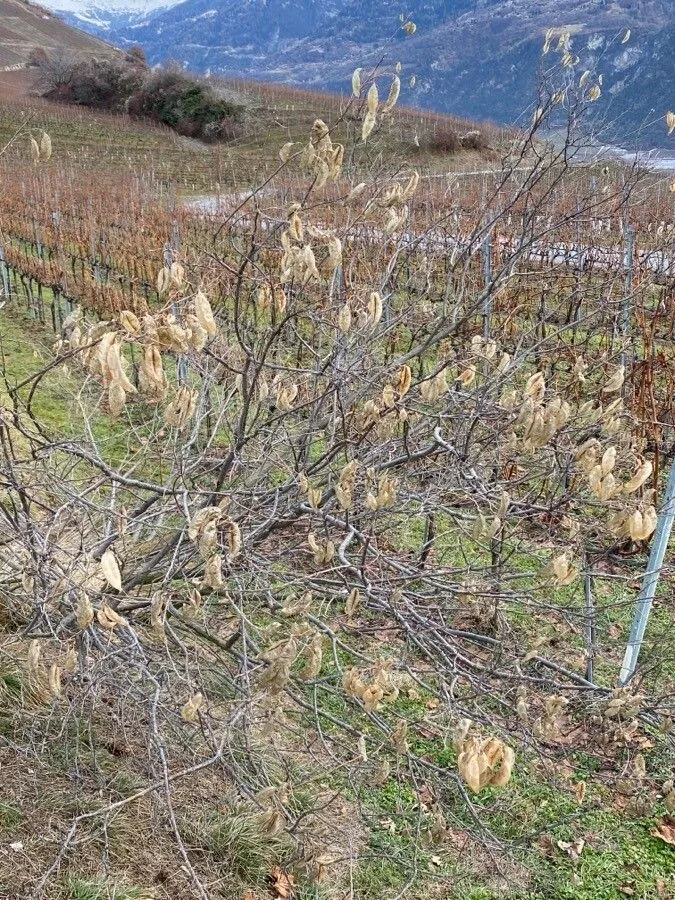
Author: L.
Bibliography: Sp. Pl.: 723 (1753)
Year: 1753
Status: accepted
Rank: species
Genus: Colutea
Vegetable: False
Observations: C. & S. Europe
Bladder-senna, known scientifically as Colutea arborescens, is an intriguing and resilient plant that belongs to the Fabaceae family. Originally documented in the seminal botanical work “Species Plantarum” by Carl Linnaeus in 1753, this species enjoys a widespread presence across central and southern Europe.
An impressive and ornamental shrub, Bladder-senna typically reaches heights of up to three meters. One of its most distinctive features is its unique bladder-like seed pods, which inflate as they mature. These seed pods not only add an unconventional aesthetic to the plant but also facilitate effective seed dispersal by wind, making Bladder-senna an adept colonizer of open, sunny spaces.
The leaves of Colutea arborescens are pinnate, comprising several small leaflets that create an elegant, feathery appearance. During the blooming season, the plant is adorned with bright yellow, pea-like flowers that are not just visually striking but also attract a variety of pollinators, such as bees and butterflies. These flowers make Bladder-senna a valuable addition to garden spaces that aim to foster biodiversity.
In its native habitats across central and southern Europe, Bladder-senna thrives in well-drained soils and is particularly suited to rocky or sandy terrains. Its ability to fix nitrogen in the soil through symbiotic relationships with root-associated bacteria makes it an ecologically significant species, contributing to soil enrichment and the support of surrounding flora.
Moreover, Colutea arborescens is often utilized for ornamental purposes in landscape design. Its hardiness and drought resistance make it a practical choice for gardeners seeking low-maintenance yet visually appealing plants. Hence, whether enhancing the aesthetic of a garden or supporting ecological stability, Bladder-senna stands out as a remarkable and multifaceted species within the plant kingdom.
Dan: almindelig blærebælg
Eng: bladder senna, bladder-senna
Deu: blasenstrauch, gewöhnlicher blasenstrauch
Swe: blåsärt, gulblommig blåsärt
Cat: espantallops
Ces: žanovec měchýřník
Nld: europese blazenstruik
Fra: baguenaudier commun, arbre à vessies, baguenaudier, cotule à feuilles de sénebière
Cym: llwyn senna, senna codog
En: Bladder-senna, Bladder senna, Bladdersenna
Ar: قنصور شجري
Az: Ağacvari şaqqıldaq
Be: Пузырнік дрэвападобны
Bg: Плюскач
Ca: Espantallops
Zh: 鱼鳔槐
Hr: Pucalina
Cs: Žanovec měchýřník
Da: Almindelig Blærebælg
Nl: Europese blazenstruik
Et: Euroopa põispõõsas (euroopa põisakaatsia)
Fi: Keltarakkopensas
Fr: Baguenaudier, Baguenaudier commun, Arbre à vessies, Cotule à feuilles de sénebière, Baguenaudier arborescent, Séné bâtard
De: Blasenstrauch, Gewöhnlicher Blasenstrauch, Baumartiger, Gelber Blasenstrauch
Hu: Pukkanó dudafürt
It: Vesicaria, Vescicaria
No: Blærebusk
Pl: Moszenki południowe
Pt: Falso sene
Sr: Пуцалина
Sk: Mechúrnik stromkovitý, Mechúrnik stromovitý
Es: Espantalobos, Sonajas, Espantazorras
Sv: Blåsärt, Gulblommig blåsärt
Zh-tw: 鱼鳔槐
Cy: Senna codog, Llwyn Senna
Taken Aug 24, 2017 by Pep Secem (cc-by-sa)
Taken Aug 24, 2017 by Pep Secem (cc-by-sa)
Taken Aug 24, 2017 by Pep Secem (cc-by-sa)
Taken Dec 5, 2017 by Dieter Wagner (cc-by-sa)
Taken Dec 5, 2017 by Dieter Wagner (cc-by-sa)
Taken Dec 1, 2021 by Guaita Raquel (cc-by-sa)
Taken Dec 1, 2021 by Guaita Raquel (cc-by-sa)
Taken May 17, 2017 by César Gonzalez (cc-by-sa)
Taken Aug 24, 2017 by Pep Secem (cc-by-sa)
Taken Dec 5, 2017 by Dieter Wagner (cc-by-sa)
Taken May 23, 2021 by Jacques Zuber (cc-by-sa)
Taken May 23, 2021 by Jacques Zuber (cc-by-sa)
Taken Jun 6, 2021 by Juju2182 (cc-by-sa)
Taken Dec 1, 2021 by Guaita Raquel (cc-by-sa)
Taken Jun 10, 2018 by Barto Barbara (cc-by-sa)
Taken Jun 29, 2012 by Tela Botanica − Yoan MARTIN (cc-by-sa)
Taken May 18, 2020 by Perez Adolfo (cc-by-sa)
Taken May 23, 2021 by Jacques Zuber (cc-by-sa)
Taken Jan 7, 2022 by Jacques Zuber (cc-by-sa)
Taken Oct 27, 2022 by Tomaž Jančar (cc-by-sa)
Taken Sep 29, 2019 by jean-jacsues lonni (cc-by-sa)
Taken Sep 29, 2019 by jean-jacsues lonni (cc-by-sa)
Taken Jan 1, 1800 by Tela Botanica − Thierry Pernot (cc-by-sa)
Taken Sep 17, 2022 by Kai Best (cc-by-sa)
Taken Sep 29, 2022 by Llandrich anna (cc-by-sa)
Taken Jun 22, 2021 by FSL A (cc-by-sa)
Taken May 7, 2021 by javad54 (cc-by-sa)
Taken Jul 7, 2022 by Fabrice Rubio (cc-by-sa)
Taken Jul 7, 2022 by Fabrice Rubio (cc-by-sa)
Taken Nov 2, 2016 by Yoan MARTIN (cc-by-sa)
© copyright of the Board of Trustees of the Royal Botanic Gardens, Kew.
© copyright of the Board of Trustees of the Royal Botanic Gardens, Kew.
Growth form: Multiple Stem
Growth habit: Tree, Shrub
Growth rate: Rapid
Ph maximum: 8.5
Ph minimum: 6.0
Light: 6
Atmospheric humidity: 4
Bloom months: [‘may’, ‘jun’, ‘jul’]
Soil nutriments: 4
Family: Myrtaceae Author: (F.Muell.) K.D.Hill & L.A.S.Johnson Bibliography: Telopea 6: 402 (1995) Year: 1995 Status:…
Family: Rubiaceae Author: Pierre ex A.Froehner Bibliography: Notizbl. Bot. Gart. Berlin-Dahlem 1: 237 (1897) Year:…
Family: Sapindaceae Author: Koidz. Bibliography: J. Coll. Sci. Imp. Univ. Tokyo 32(1): 38 (1911) Year:…
Family: Asteraceae Author: A.Gray Bibliography: Pacif. Railr. Rep.: 107 (1857) Year: 1857 Status: accepted Rank:…
Family: Fabaceae Author: Medik. Bibliography: Vorles. Churpfälz. Phys.-Ökon. Ges. 2: 398 (1787) Year: 1787 Status:…
Family: Aspleniaceae Author: (Cav.) Alston Bibliography: Bull. Misc. Inform. Kew 1932: 309 (1932) Year: 1932…